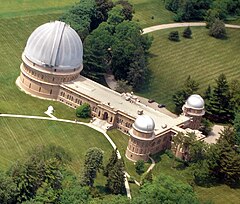Yerkes Observatory
 |
|||||||||||
| Organization | University of Chicago | ||||||||||
|---|---|---|---|---|---|---|---|---|---|---|---|
| Code | 754 | ||||||||||
| Location | Williams Bay, United States of America | ||||||||||
| Coordinates | 42°34′13″N 88°33′22″W / 42.570277777778°N 88.556111111111°WCoordinates: 42°34′13″N 88°33′22″W / 42.570277777778°N 88.556111111111°W | ||||||||||
| Altitude | 334 m (1,096 ft) | ||||||||||
| Website | astro |
||||||||||
| Telescopes | |||||||||||
|
|||||||||||
|
[]
|
|||||||||||
| 40-inch (102 cm) | refractor |
|---|---|
| 40-inch (102 cm) | reflector |
| 24-inch (61 cm) | reflector |
| 10-inch (25 cm) | Cassegrain reflector |
| 7-inch (18 cm) | Schmidt camera |
Yerkes Observatory is an astronomical observatory in Williams Bay, Wisconsin operated by the University of Chicago Department of Astronomy and Astrophysics. The observatory, which calls itself "the birthplace of modern astrophysics," was founded in 1897 by astronomer George Ellery Hale and financed by businessman Charles T. Yerkes. It represented a shift in the thinking about observatories, from their being mere housing for telescopes and observers, to the modern concept of observation equipment integrated with laboratory space for physics and chemistry.
The observatory houses a 40" refracting telescope, the largest ever successfully used for astronomy. and a collection of over 170,000 photographic plates. The director of the observatory is Doyle "Al" Harper. Notable astronomers who have conducted research at Yerkes include Edwin Hubble (who did his graduate work at Yerkes and for whom the Hubble Space Telescope was named), Subrahmanyan Chandrasekhar (for whom the Chandra Space Telescope was named), prolific Russian-American astronomer Otto Struve, and the twentieth-century popularizer of astronomy Carl Sagan.
Yerkes Observatory's 100 cm (40 in) refracting telescope was built by the refracting telescope company Alvan Clark & Sons. It is the largest refracting telescope used for scientific research. (A larger demonstration refractor, the Great Paris Exhibition Telescope of 1900, was exhibited at the Paris Universal Exhibition of 1900.) The mounting and tube for the 100-centimeter (40 in) telescope was exhibited at the 1893 World's Columbian Exposition in Chicago before being installed in the observatory. The grinding of the lens was completed later.
...
Wikipedia
